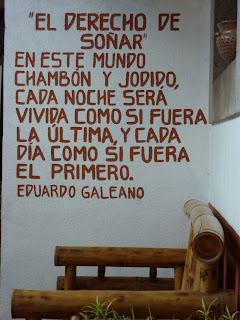Thanks to built up expectations, I
wasn’t enamored with the town of Suchitoto on my first visit. This past week I had the opportunity to
go again, with the intention of revisiting Lago Suchitlan. With limited time, my visiting friend
and I found ourselves at the main square. We were quickly drawn to the Molino on the corner where the women in
town bring their corn to be ground.
The owner of the place welcomed us in to watch and was happy to answer
our questions. Afterwards, we
walked a few blocks to visit the Centro Arte para la Paz. We were delighted by the place,
impressed by their mission and vision, clearly portrayed throughout the
center. Back on the square we had
time for a quick lunch at La Lupita del Portal. I recharged from the heat with
a large limonada and a plate of grilled vegetables and pineapple served with
baguette and chirmol (a green salsa).
It was the perfect light lunch in a sweet environment. Upon leaving I felt charmed by “ciudad
antigua”, the original San Salvador in the 1500s. The town has been through many hardships including invading
Spaniards and the more recent civil war.
Despite the history, the place has found a way to thrive with their art,
culture, and tourism, while still managing to retain their traditions. On this visit I was reminded that my
first impressions aren’t always the best impressions and was thankful to have
the chance to re-experience Suchitoto.
El Molino – For over 26 years the owner has been grinding corn,
rice, wheat, pumpkin, meat, coffee, and hard cheese for the town of Suchitoto.
Centro Arte para la Paz
A center
offering a museum, art shows, garden, hostel, and classes
of all kinds
including music and art.
“To create a culture
of peace through the arts, promoting creativity, imagination,
and cultural
exchange with the participation of all the people of Suchitoto.”
View of the main square from La Lupita del Portal.






























